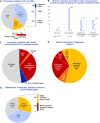The role of recessive inheritance in early-onset epileptic encephalopathies: a combined whole-exome sequencing and copy number study
- PMID: 30552426
- PMCID: PMC6460568
- DOI: 10.1038/s41431-018-0299-8
The role of recessive inheritance in early-onset epileptic encephalopathies: a combined whole-exome sequencing and copy number study
Abstract
Early-onset epileptic encephalopathy (EE) and combined developmental and epileptic encephalopathies (DEE) are clinically and genetically heterogeneous severely devastating conditions. Recent studies emphasized de novo variants as major underlying cause suggesting a generally low-recurrence risk. In order to better understand the full genetic landscape of EE and DEE, we performed high-resolution chromosomal microarray analysis in combination with whole-exome sequencing in 63 deeply phenotyped independent patients. After bioinformatic filtering for rare variants, diagnostic yield was improved for recessive disorders by manual data curation as well as molecular modeling of missense variants and untargeted plasma-metabolomics in selected patients. In total, we yielded a diagnosis in ∼42% of cases with causative copy number variants in 6 patients (∼10%) and causative sequence variants in 16 established disease genes in 20 patients (∼32%), including compound heterozygosity for causative sequence and copy number variants in one patient. In total, 38% of diagnosed cases were caused by recessive genes, of which two cases escaped automatic calling due to one allele occurring de novo. Notably, we found the recessive gene SPATA5 causative in as much as 3% of our cohort, indicating that it may have been underdiagnosed in previous studies. We further support candidacy for neurodevelopmental disorders of four previously described genes (PIK3AP1, GTF3C3, UFC1, and WRAP53), three of which also followed a recessive inheritance pattern. Our results therefore confirm the importance of de novo causative gene variants in EE/DEE, but additionally illustrate the major role of mostly compound heterozygous or hemizygous recessive inheritance and consequently high-recurrence risk.
Conflict of interest statement
The authors declare that they have no conflict of interest.
Figures


References
Publication types
MeSH terms
LinkOut - more resources
Full Text Sources
Other Literature Sources
Medical
Molecular Biology Databases

